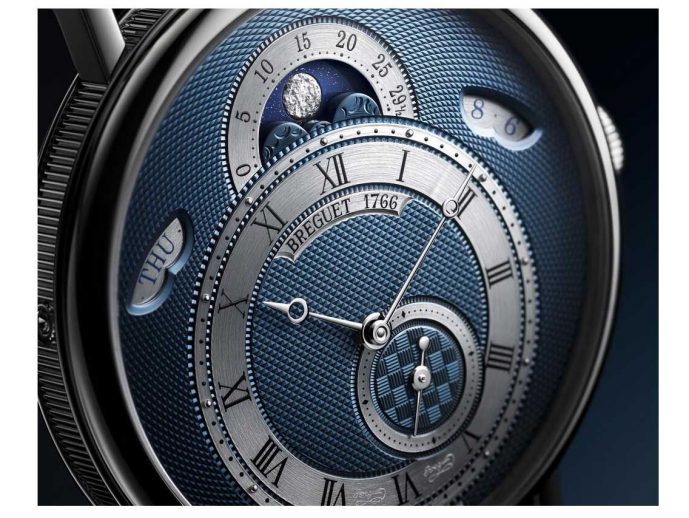Categories more
- Adventures (17)
- Arts / Collectables (15)
- Automotive (37)
- Aviation (11)
- Bath, Body, & Health (77)
- Children (6)
- Cigars / Spirits (32)
- Cuisine (16)
- Design/Architecture (22)
- Electronics (13)
- Entertainment (4)
- Event Planning (5)
- Fashion (46)
- Finance (9)
- Gifts / Misc (6)
- Home Decor (45)
- Jewelry (41)
- Pets (3)
- Philanthropy (1)
- Real Estate (16)
- Services (23)
- Sports / Golf (14)
- Vacation / Travel (60)
- Watches / Pens (15)
- Wines / Vines (24)
- Yachting / Boating (17)
Published
06/09/2020 by BreguetThanks to its mastery of the art of guilloche work, Breguet is giving a new face to two emblematic models from its Classic collection, the 7137 and the 7337. The House offers these new versions in pink gold with a silver gold dial but also, in a more contemporary register, in white gold with a gold dial in "Breguet blue" color. A raised moon on a starry sky brings a new dimension to the display of moon phases.
With a timeless elegance, the Classic line is in the purest Breguet style. The Manufacture revisits the Classic 7137 and 7337 models - inspired by historic watches - thanks to one of its specialties: traditional guilloche. On the silvered gold or “Breguet blue” dials, new versions of this year, the variations in patterns make it possible to differentiate the reading zones in all sobriety. The time is easily read using Breguet “hollowed out” hands and Roman hours. True to its traditions born in the late 18 thcentury, the Maison affixes the individual number of the watch on the dial and engraves a secret signature on it. The Classic models have a thin box with fluted sides. The fasteners, welded for the sake of solidity and curved for wearing comfort, hold the leather strap. The ultra-thin caliber 502.3 with an oscillating weight in gold guilloche by hand animates these models, 39 mm in diameter.
Breguet Classic 7137
The traditional know-how of hand guilloche work is expressed to the full in the Classic line. Like two centuries ago, the craftsman performs it on a guilloche lathe - for circular decorations - or on a "straight line machine" for linear patterns. The Classique 7137 has a “mesh basket” motif for the display of the power reserve, “checkerboard” for the date display and “clous de Paris” for the main part of the dial. The dial of the white gold version adopts Breguet blue. On the pink gold version, the shade of the dial is born from the installation of silver powder, then worked with a soft brush.
Breguet Classic 7337
The dial of the Classique 7337 shows patterns of great finesse: circular “barley grain” for the exterior of the hour clock, “checkerboard” for the small seconds and “clous de Paris” in the center. Engraved clouds line the lacquered sky of the moon phase, studded with glitter evoking the Milky Way. Breguet reshapes the gold dot depicting the moon in polished reliefs and matt hollows. At ten o'clock and two o'clock, two openings, whose shapes recall those of historical models, such as the pocket watch no. 3833, display the day and the date.
All in finesse
The sapphire crystal of the Classic 7137 and the Classic 7337 reveals the ultra-thin automatic caliber 502.3 decorated by hand. This movement has a reduced thickness, thanks to an open barrel and an off-center oscillating weight. This particular design makes it possible to distinguish the barrel spring, otherwise concealed. The use of a silicon balance spring from recent technological research continues Abraham-Louis Breguet's quest for precision on contemporary ground.
The origins of the Classic
Sober and elegant, the new Classique 7137 and Classique 7337 interpret on the wrist the aesthetics of historic pocket watches produced under the leadership of Abraham-Louis Breguet and his son. From 1786, the watchmaker added the art of guilloche work to watchmaking codes, and this in the service of legibility. Source of inspiration for the Classic 7137 model, the Perpétuelle n ° 5 pocket watch has several guilloche patterns as well as an hour turn with Roman numerals.
Major stylistic innovation, the offset dials were introduced around 1812 on certain pocket watches. Thus, the repetition of the quarters n ° 3833, sold in 1823 and exhibited at the Breguet museum in Paris, displays an hour turn moved at VI hours, surmounted by the indication of the moon phases at XII hours, a provision which the '' current Breguet Classique 7337.
From the end of the 1930s, Breguet reintroduced several classic codes of these pocket watches on the wristwatch scale, with guilloche dials and fluted case boxes. The House confirms this trend between the 1950s and 1970s, announcing the current Classic collection.















